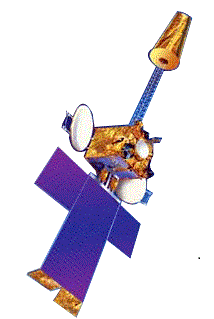
The Indian National Satellite System or INSAT, is a series of multipurpose geostationary satellites launched by ISRO to satisfy telecommunications, broadcasting, meteorology, and search and rescue operations. Commissioned in 1983, INSAT is the largest domestic communication system in the Indo-Pacific Region. It is a joint venture of the Department of Space, Department of Telecommunications, India Meteorological Department, All India Radio and Doordarshan. The overall coordination and management of INSAT system rests with the Secretary-level INSAT Coordination Committee.
NSS-6 is a communications satellite owned by SES WORLD SKIES.

The Master Control Facility (MCF) is a facility set up by the Indian Space Research Organisation (ISRO) in the city of Hassan in the Indian state of Karnataka. Established in 1982, this facility is responsible for monitoring and controlling geostationary and geosynchronous satellites launched by ISRO. This was the only Master Control Facility of ISRO till another one was established in Bhopal in 2005.
The Intelsat VI series of satellites were the 8th generation of geostationary communications satellites for the Intelsat Corporation. Designed and built by Hughes Aircraft Company (HAC) in 1983-1991, there were five VI-series satellites built: 601, 602, 603, 604, and 605.
INSAT-3D is a meteorological, data relay and satellite aided search and rescue satellite developed by the Indian Space Research Organisation and was launched successfully on 26 July 2013 using an Ariane 5 ECA launch vehicle from French Guiana. The satellite has many new technology elements like star sensor, micro stepping Solar Array Drive Assembly (SADA) to reduce the spacecraft disturbances and Bus Management Unit (BMU) for control and telecom and telemetry function. It also incorporates new features of bi-annual rotation and Image and Mirror motion compensations for improved performance of the meteorological payloads.
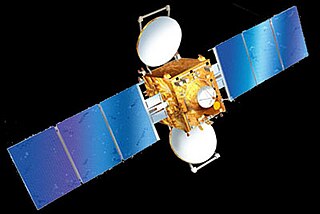
INSAT 3E is a defunct communication satellite built by Indian Space Research Organisation. It was launched on September 28, 2003, from the European Space Agency's spaceport in French Guiana on board the Ariane rocket. The satellite had a launch mass of 2750 kilograms. It is the 4th satellite launched in the INSAT-3 series for INSAT. It was designed for providing high-speed communication, Television, VSAT & Tele-education services and was an important landmark in Indian Space Programme.
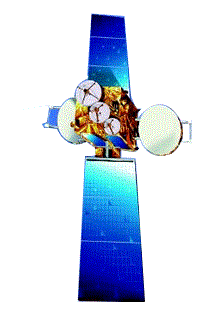
INSAT-3C is a multipurpose satellite built by ISRO and launched by Arianespace in Jan 2002. INSAT-3C is the second satellite of the INSAT-3 series. All the transponders provide coverage over India. Insat-3C is controlled from the Master Control Facility at Hassan in Karnataka. It will provide voice, video and digital data services to India and neighboring countries.

INSAT-4A was the first one in the INSAT-4 Satellites series, providing services in the Ku and C band frequency bands. At the time of launch, it was the heaviest satellite India had produced. The Ku transponders cover the Indian main land and C-Band transponders cover an extended area. It has a dozen Ku transponders and another dozen of C-band transponders. This spacecraft was placed at 83°E along with INSAT-2E and INSAT-3B, by Ariane launch vehicle (ARIANE5-V169).
GSAT-10 is an Indian communication satellite which was launched by Ariane-5ECA carrier rocket in September 2012. It has 12 KU Band, 12 C Band and 6 lower extended c band transponders, and included a navigation payload to augment GAGAN capacity. Following its launch and on-orbit testing, it was placed in Geosynchronous orbit at 83.0° East, from where it will provide communication services in India.

Intelsat 901 (IS-901) is the first of nine new Intelsat satellites launched in June 2001 at 18° West, providing Ku-band spot beam coverage for Europe and C-band coverage for the Atlantic Ocean region. It is capable of selectable split uplink for Satellite news gathering (SNG), tailored for increased communications demands such as DTH and Internet.
INSAT-1C was the third in the first generation INSAT series of satellites built by Ford Aerospace to satisfy the domestic communication requirement of India. The Govt. agencies using its services were All India Radio, Doordarshan, Department of Space and Indian Meteorological Department
INSAT-2B was the second satellite in the INSAT 2 Series that was successfully launched for telecommunication and meteorological observation. This India satellite was launched on 23 July 1993 from Kourou, French Guiana and Ariane-4 being its launch vehicle. INSAT-2B is placed in the geostationary orbit at a longitude of 93.5 degree East. The satellites also carries a search and rescue(SAR) transponder, a data relay transponder and also high resolution radiometer. This radiometer has a resolution of 2 km (1.2 mi) in the normal visible band and of 8 km (5.0 mi) in the thermal infra red band.
GSAT-7 or INSAT-4F is a multi-band military communications satellite developed by the Indian Space Research Organisation. The Indian Navy is the user of the multi-band communication spacecraft, which has been operational since September 2013. According to defense experts, the satellite will enable the navy to extend its blue water capabilities and stop relying on foreign satellites like Inmarsat, which provide communication services to its ships.
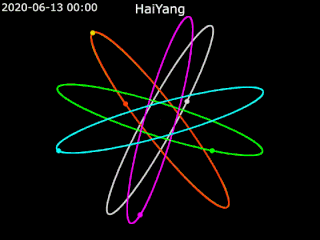
Haiyang is a series of marine remote sensing satellites developed and operated by the People's Republic of China since 2002. As of October 2022, eight satellites have been launched with ten more planned. Built by the state-owned aerospace contractor China Academy of Space Technology (CAST), Haiyang satellites carry a variety of ocean-imaging sensor payloads and are operated by the National Satellite Ocean Application Service (NSOAS), a subordinate agency of the State Oceanic Administration (SOA). Haiyang satellites are launched from Taiyuan Satellite Launch Center (TSLC) into Sun-synchronous orbit (SSO) aboard Long March-series rockets.

Es'hail 2 is a Qatari satellite, launched aboard a SpaceX Falcon 9 rocket on November 15, 2018. Es'hail 2 was built by Japan's Mitsubishi Electric company, and operates at 26° East longitude along a geostationary orbit to provide direct-to-home television services in the Middle East and North Africa region. The satellite features 24 Ku-band and 11 Ka-band transponders to provide direct broadcasting services for television, government and commercial content distribution. In addition to commercial services, the payload of Es'hail 2 includes a linear transponder with a bandwidth of 500 kHz and 8 MHz for the amateur radio satellite service, with uplink on 2.4 GHz and downlink on 10.45 GHz.
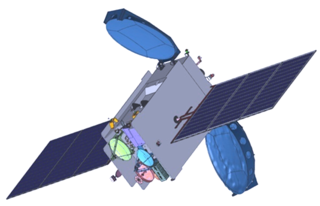
GSAT-17 is an Indian communications satellite. Built by ISRO and operated by INSAT, it carries 24 C-band, 2 lower C-band, 12 upper C-band, 2 CxS, and 1 SxC transponders. It additionally carries a dedicated transponder for data relay (DRT) and search-and-rescue (SAR) services. At the time of launch, GSAT-17 was the heaviest satellite built by ISRO.
Intelsat 706 is a geostationary communication satellite that was built by Space Systems/Loral (SSL). It is located in the orbital position of 157 degrees east longitude and it is currently in an inclined orbit. The same is owned by Intelsat. The satellite was based on the LS-1300 platform and its estimated useful life was 15 years.
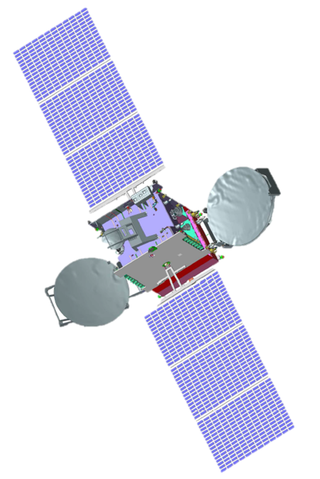
GSAT-30 is a telecommunications satellite developed by the Indian Space Research Organisation (ISRO).

INSAT-2D was an Indian communications satellite. Launched on 4 June 1997, and similar to INSAT-2C, INSAT-2D went out of order on October 4, 1997, because of a power inconsistency problem and was later replaced by INSAT-2DT, an in-orbit satellite which was previously known as ARABSAT-1C. The main aim of the satellite was improved communication. In the INSAT-2 series, INSAT-2D was the fourth consecutive communication satellite. The satellite was launched using an Ariane 4 rocket from French Guiana.
INSAT-2C was an Indian geostationary communications spacecraft. It is ISRO's third indigenous communications satellite.
